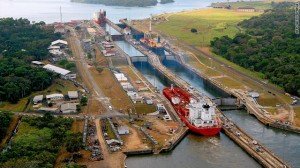 (Panama America) The Panama Canal works to offset their emissions of greenhouse gases and become “carbon neutral” from 2014, today announced the administrator of the waterway, German Alberto Zubieta.
(Panama America) The Panama Canal works to offset their emissions of greenhouse gases and become “carbon neutral” from 2014, today announced the administrator of the waterway, German Alberto Zubieta.
During the celebration of “Panama: Where the World Meets”, organized by the Americas Society and Council of the Americas, explained that German road administration carries out a program of environmental management of its operations, started in 1914.
He noted that prepares the reforestation of 20,000 hectares of forests to “make carbon neutral Canal (offset CO2 emissions with carbon sequestration by forests) in 2014.”
In addition, explained that the Panama Canal Authority (ACP) is working with the private sector and the Smithsonian Tropical Research Institute to “measure the impact on Panama’s forests planted in native and nonnative species.”
Another factor that will help conservation is that the third set of locks that are currently being built as part of enlargement, will be attached baths to reuse water used in the passage of ships from 2014, which will generate savings.
The event, focusing on logistics development in Panama, served as a German to take stock of the management of the Canal since its opening and to emphasize that since 1965 began to raise the demand for its services since 1970 began arriving ships Panamax, the largest passing through the road.
World War II did not allow the expansion of the Canal in the 1940’s, he said, but for their maintenance and modernization have invested over 1,600 million dollars in recent years.
Currently, 50 percent of the ships passing through the route, about 13,000 a year are Panamax.
The Business Channel is not passing ships, if not move cargo, he said.
German added that the time to travel the route was reduced from 31 hours in 2007 to 17 to 21 hours today, while his main route is from Asia to U.S. East Coast
After detailing the main aspects of the Canal expansion, budgeted at U.S. $ 5,250 million, German said the development of this work is progressing according to schedule and awarded several contracts have a much lower cost than estimated.
The new work will allow Post Panamax ships of 12,600 TEUs to pass, when currently the maximum is 4,400 TEU, tripling the capacity that can cross the Channel.
TEU is the abbreviation of the term in English Twenty-feet Equivalent Unit and represents the unit of measurement of shipping capacity in containers of 20 feet.
Germany stressed the high level of professional and technical development of its staff and said that this led to multinational companies such as Caterpillar to open a training center in the country.
Also, due to the redevelopment of the canal, cement factories doubled its installed capacity to meet demand and then become exporters.
In Latin America, recalled the first place is occupied Panama ports, above the port of Santos in Brazil and the country has more cranes than Brazil, Mexico and Chile, accounting for 23% of all in the region.
With regard to logistics development, Canal Administrator found that the region “needs to increase its port capacity, air and land transport. There are bad roads and customs systems. What we are seeing is how to maximize the geographical position of Panama,” he said.
“We have much to do as a society, we must understand and explain these benefits to people,” he said German, who warned that the expansion “should have an impact on all levels of Panamanian society.”